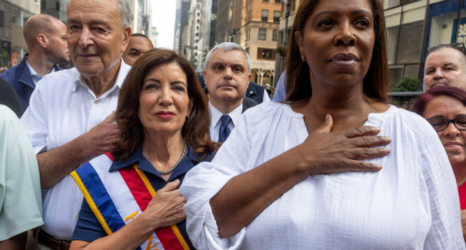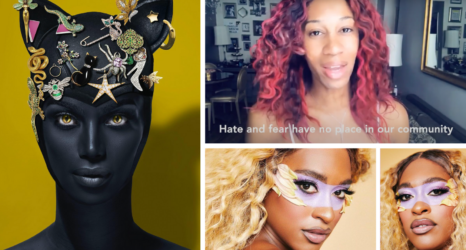Like so many others, I have been distressed by news coverage about Ferguson, Missouri, where protests broke out following the murder on August 9 of Michael Brown, an unarmed teenager who was shot six times by a police officer.
Whether following it on TV or Twitter, there was no escaping the chilling fact that Black bodies are constantly under surveillance, policing, and (lethal) punishment, even as protestors emphatically insisted that “Black lives matter.”
Images of a militarized police force rendering a predominantly Black, low-income suburban community under siege are reminiscent of earlier moments in this country’s traumatic racial history. Think Watts, Detroit or New Orleans during the Hurricane Katrina aftermath. We don’t always have to travel overseas for immediate comparisons.
One of the photojournalists, Scott Olson, who has given us powerful images of the Ferguson protests was arrested briefly while doing his job. Although some of his photos have already become iconic, there is one that held a great deal of resonance for me.
The image shows a sole Black woman standing in the middle of a street, surrounded by tear gas and facing down the riot police shooting off sparks and rubber bullets. She positions her hands in the air—the recognizable gesture now mobilizing a generation of social-justice seekers simultaneously surrendering and resisting: “Hands Up! Don’t Shoot!”
Here is a woman placing her body on the line. Her upheld hands indicating all things at once: surrender, despair, resistance, fearlessness and triumph. In that moment, her body will not be silenced, will not be muted, will not be incomprehensible.
Love the Ms. Blog? Become a Ms. Partner and support our fierce, feminist reporting!
See, Black women don’t just show up in solidarity for Black men, their sons, their brothers, their fathers, their partners. They, too, are targets. As Kirsten West Savali recently reminded us: “Black Women Are Killed by Police, Too.”
So, when I was asked to provide some reflection on Taylor Swift’s new video, “Shake It Off,” my immediate response was: That silly distraction? Why?!
Of course, I’ve had time to re-watch it to form a deeper analysis, right around the same time that Nicki Minaj released her own video, “Anaconda,” weeks after the controversial cover art for the single.
There is something to be said for listening to and watching comedic and fluffy entertainment in the midst of chaos and anger. Sometimes we need a reprieve, and creating a mixtape of politically conscious Marvin Gaye songs alongside “party music” is perhaps a therapeutic response to rage and despair.
Unfortunately, neither of these comedic videos by Taylor Swift and Nicki Minaj provided me with the necessary escapism. They were far too steeped in the racial politics of women’s bodies, the same racialized lens that would cause a militarized police force to descend upon a city with racialized fear.
Both videos make use of backup “twerk” dancers, although Nicki Minaj aligns her own body with these dancers; she creates a multiracial sisterhood with other booty-shaking women. Twerking is that dance craze that has so many parents across this country hand-wringing over the sexualization of our culture. That this dance started in the heavily policed communities of low-income people of color reinforces white fears of Black bodies—be they sexualized or criminalized.
When white pop stars such as Miley Cyrus and Iggy Azalea are rendered “cool” and given “street” credibility for populating their music videos with such Black female bodies in the background, they are simultaneously breaching that segregated Black space by bringing it into white middle-class homes, thus inciting fears of cultural decline and racial impurity. We only need listen to the anxieties already expressed about the upcoming MTV VMA awards show and the excessive display of “twerking” booties that is sure to be televised. That racialized fear of Black female hyper-sexuality also transfers onto the sexualized white female body and the criminalized Black male body.
So, when Taylor Swift deliberately positions her awkwardly dancing body in “Shake It Off” as a way to defend her innocence against the constant slut-shaming she has experienced, she reifies her whiteness, her purity. Her rhythm-less dance moves distance her from the hyper-sexualized racial body in a way that positions her as somehow morally “safe” when compared to her white female counterparts Iggy Azalea and Miley Cyrus. She also trafficks in white female stereotypes when she positions herself as a failed cheerleader and ballerina, which would be cutesy if the recent commercial for Under Armour, featuring Black ballerina Misty Copeland, didn’t remind me of Copeland’s embodied struggles for acceptance in the white elite world of ballet.
Considering the high stakes that Black ballet dancers face in which any playfulness would immediately disqualify their bodies as “appropriate” or “feminine,” Taylor Swift’s awkwardness is a form of white privilege. There is also a racialized lens that is applied to this awkwardness, which connotes sexual innocence that protects the pop star from the charges of sexual excess to which she has been subjected.
This is why, as a Black female entertainer, Nicki Minaj’s own defense against slut-shaming is not to distance herself from these hypersexual images but instead to embrace them, to poke holes in them, to remix and then signify on them. It is no coincidence that Nicki remixes as a hook the “white girl” vocals from Sir Mix-A-Lot’s “Baby Got Back“: “Oh. My. God…Look at her butt!” We can almost imagine Taylor’s own voice here when we see how her appropriation of twerking bodies invites the same incredulity and mockery. Nicki Minaj engages in parody as well, but her body is also placed on the line—culturally—and becomes the subversive signifier of excess sexuality, which she simultaneously denies to the male onlooker at the end of the video.
At any other time, such videos could be read as resistant responses by female pop stars negotiating public and male gazes; but in this heightened environment of crisis and protests, these performative bodies merely remind us of prevailing racial and sexual fears that threaten to engulf us all. Women’s bodies become the site for either reification or resistance—on the streets and in media.
Get Ms. in your inbox! Click here to sign up for the Ms. newsletter.
Photo courtesy of Flickr user marsmettn tallahassee licensed under Creative Commons 2.0 and music video stills via YouTube.





